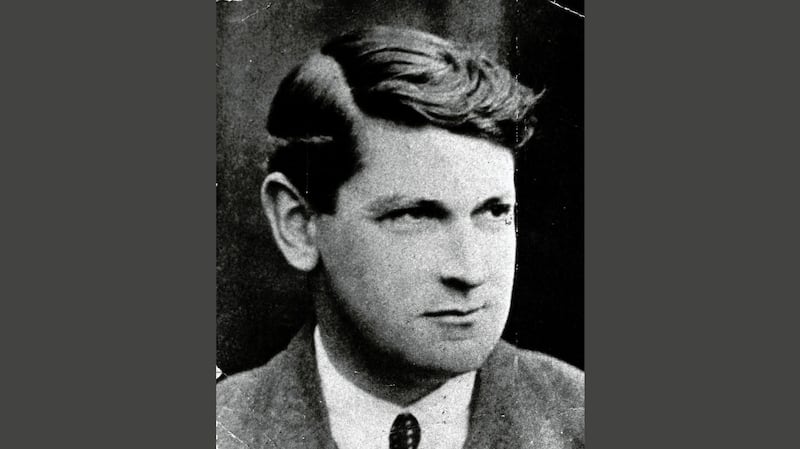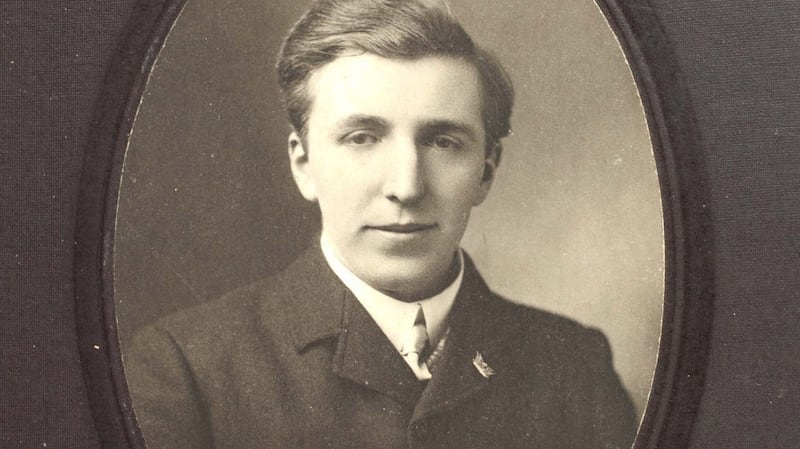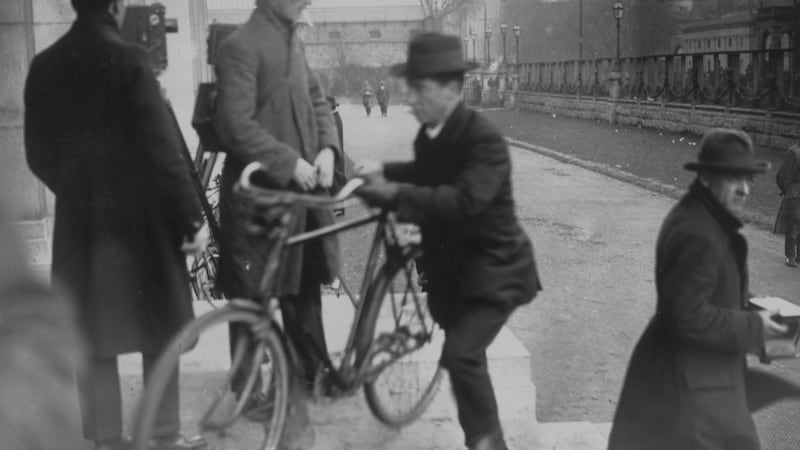In 1912, journalist and Irish-language activist Piaras Béaslaí visited Tom Clarke in his tobacconist shop in Parnell Street in Dublin. He found Clarke “sitting on a chair in the same position as, when a convict, he used to sit on a stool in his cell, trunk erect, gazing into the distance, his eyelids hardly moving, his hands resting on his knees”.
That Clarke was there at all was quite an achievement. He had been a prisoner in English jails from 1883 to 1898, having been convicted of treason-felony after a bombing mission he undertook in England as a member of the Irish Republican Brotherhood (IRB). The IRB was a secret oath-bound organisation established in Ireland in 1858 along with its American counterpart the Fenian Brotherhood (the Fenian label a nod to ancient Irish warriors), which evolved in to Clan na Gael. IRB members were dedicated to the establishment of a democratic Irish republic through force of arms.
Clarke served most of his sentence in Chatham prison, enduring a brutal regime of hard labour and enforced silence in what was described as “a living tomb”. His exceptional mental resilience sustained a journey that ended in 1916 when he was executed aged 59 as the eldest and first of the signatories of the 1916 Proclamation.
Clarke died content as a committed IRB stalwart, “more satisfied than for many a day” as he told his wife Kathleen before his execution. His seniority, status and single-mindedness had a profound impact on those immersed in separatist circles in the years leading to the Rising. Béaslaí was one of them, belonging to the Teeling circle of the IRB, along with the likes of Cathal Brugha, Seán MacDiarmada and Bulmer Hobson, but while these men – and this story is overwhelmingly male – may have shared IRB membership, they did not necessarily agree on how and when to achieve the Irish republic. They went in different directions, sometimes fell out, and those who lived to tell tales presented often conflicting narratives, the IRB story inevitably complicated by the nature of secret societies.
READ MORE
The strength of this dense book rests with the multiplicity of such narratives, their detail, vividness and contradictions providing a worthy overview of the personalities and tensions involved in the Fenian story. It is also the culmination of a very personal mission, as the author’s father was a committed IRB and IRA man. O’Beirne Ranelagh, who studied history at Oxford and was an associate producer on Robert Kee’s acclaimed television history of Ireland in the early 1980s, spent considerable time in the early 1970s interviewing the Irish revolutionary veterans, greatly assisted by his father’s “status and contacts”. This book draws on more than 100 such interviews, promising to “lift the veil” on the organisation.
While the research underpinning it is detailed and layered and it includes copious footnotes and makes admirable use of recently released sources, the author does not engage with some of the wider contextual questions posed by other historians of the IRB, and is prone to chronological rambling and sweeping assertions, but it is nonetheless valuable, comprehensive and often insightful. The IRB is deserving of the sustained attention he has devoted to it; decades ago, historian TW Moody rightly suggested Fenianism “as an ideal ... proved to be the most militant, pervasive and undeviating influence in Irish politics down to 1916″. The Rising of that year was very much its creation.

Michael Collins, as the best known of post-1916 IRB men, looms large (and is eulogised by various testimonies throughout), and the author suggests that if the IRB’s strength came largely from Collins, president of the IRB from 1919-21, so did its weaknesses: “he habitually cut through the hierarchy of the organisation to deal directly with members at all levels, reducing its coherence and discipline, ultimately making it dependent on him”. The author is clear in his disapproval of the IRB’s shadow; “terror and rebellion” were its defining elements and “its legacy to modern Ireland”. It was also an organisation steeped in an attitude of moral superiority; when O’Beirne Ranelagh interviewed former senior member Tom Maguire in 1973, his contention was that “if everybody else failed, the IRB would hold for the republican tradition”.
[ Metropolitan rebel — Ronan McGreevy on London and the making of Michael CollinsOpens in new window ]
This was the exalted terrain it inhabited, but it could not survive the fallout from the Anglo-Irish Treaty and Civil War from 1921-3. While many of its members could live with compromise, others, as Peadar O’Donnell told the author in 1973, “weren’t capable of coming down from the high ground of the Republic”.
Larry de Lacy, another journalist member, described the IRB as “that curious live core ... the power cell”. Organised in “cells,” each led by a “centre,” governed by a partially elected Supreme Council (SC), the IRB, after the short-lived and easily crushed Fenian rebellion of 1867, had acquired a formal constitution in 1873, with the SC “declared in fact as well as by right, the sole government of the Irish republic”. It was often torn between its underground status and its desire to infiltrate and control overground organisations, including Sinn Féin, the Gaelic League and the Irish Volunteers (which evolved into the IRA), and there was much crossover between the groups.
The assertion that it “voiced liberalisations but was not really interested in social issues” needs much more elaboration (“no rich men in any part of the movement, very odd that,” Michael Hayes recalled). According to the 1873 constitution it was required to “await the decision of the Irish nation as expressed by a majority of the Irish people as to the fit hour of inaugurating a war against England”. How that decision was to be measured was “left to the imagination” or, more accurately, left to the preferences of those heading the IRB, as according to the constitution the “authority of the SC shall be unquestioned”. This troubled some, including Hobson, elected to the SC for Leinster, who did not participate in 1916.

Having been revitalised in the early 20th century, from 1915 its military committee was active, and the 1916 Proclamation was very much an IRB document. Patrick Pearse, who had been admitted to membership in late 1913, in many ways presaged the future difficulties for the IRB. As he saw it, with the 1916 Rising, “we will save the soul of the nation” while those of a more political bent, including Irish Volunteers chief of staff Eoin Mac Neill who opposed the Rising, “will preserve the body. The body will later respond when the soul is revived”.
The IRB never solved the body-and-soul dilemma. By the end of 1917 there were about 350 IRB circles with a membership of 3-4,000 but its quest to control both the subsequent Dáil and the IRA was problematic given the multitude of power alliances and allegiances. Some, such as Denis McCullough, believed the IRB “had served its purpose in bringing about the Rising”.
Many IRB members were sceptical of politicians; a measure of the arrogance was that Frank Henderson saw the IRB as pivotal “so that a firm stand could be taken” if the temptation of a “lowering of the national objective” occurred, another manifestation of the desire to act as moral arbiters. But equally significant, as recalled by Liam Ó Britain, was that IRB membership “strengthened the feeling of being soldiers under orders, that they had sworn an oath to fight”.
Yet there were also an oath to bind the IRA to the Dáil during the War of Independence, and while IRB members dominated the IRA’s executive, it failed to control Sinn Féin to the extent it wished. Brugha, as Sinn Féin’s minister for defence, remained deeply hostile to the IRB. While it was decided that IRB members could take the Dáil oath, accepting the Dáil government’s authority, the IRB maintained its claim to the presidency of the Republic. Éamon de Valera, who the author curiously dismisses as “a sentimentalist”, had long left the IRB and resented its secret machinations.

While Collins kept the IRB hierarchy informed of aspects of the Treaty negotiations and persuaded many senior members to come on board, “lower down IRB members were not so persuadable”. Of the pro-Treaty TDs, 39 per cent were IRB members; the figure was 33 per cent for anti-Treaty TDs. Collins sought unsuccessfully to deploy the IRB to maintain a unified IRA, but the IRB was, by early 1922, struggling to function as a national organisation. A measure of the nonsense was that a new draft constitution for the IRB in July 1922 while “accepting the present governmental position of An Saor Stát”, still referred to the SC as the “sole government of the Irish republic”, while Collins depended on IRB executive colleagues to command key posts in the new National Army.
[ Contesting the silence: Irish language writers on the Civil WarOpens in new window ]
It was surely wishful thinking, however, for some Free State ministers to want to reorganise the IRB “that might then provide the mechanism through which the IRA might surrender their weapons”. Conflicting loyalties were to manifest themselves in threatened mutiny in the army in 1924, and Richard Mulcahy as minister for defence had to fall on a much-blunted IRB sword. Trying to balance the influence of different army wings, including the IRB one, ensured serious discipline problems and defiance. The IRB was wound up in 1924 with £3,809 cash on hand (about £200,000 in today’s terms). Some of that was to be spent on a history of the organisation written by Seán Ó Muirthuile, a former executive member. O’Beirne Ranelagh has now added his own painstaking and valuable version.
Diarmaid Ferriter is Professor of Modern Irish History at UCD. His new book, The Revelation of Ireland 1995-2020, will be published in September by Profile Books.
Further Reading
In 1976, Terence de Vere White, literary editor of The Irish Times, praised civil servant and historian León Ó’Broin as “our leading authority on the cloak and dagger aspects of Irish history”. This was a response to Ó’Broin’s Revolutionary Underground: The story of the Irish Republican Brotherhood 1858-1924, a book that underlined the IRB’s fluctuating power and the calibre of its personalities and which made valuable use of police reports. Vincent Comerford’s The Fenians in Context: Irish Politics and Society, 1848-82 (1985) poured cold water on the idea the Fenians represented “an inexorable national spirit” and depicted much of its appeal as social, or “patriotism as pastime”. More recently, younger historians have sought to broaden the narrative of Fenianism beyond the milestones of 1867 and 1916, reflected in Owen McGee’s The Irish Republican Brotherhood from the Land League to Sinn Féin (2005) and Matthew Kelly’s The Fenian Ideal and Irish Nationalism (2006); Fenianism, suggested Kelly, was “deeply embedded in the texture of Irish identity” in the late 19th century.
[ Jostling for their place in the rise to rebellionOpens in new window ]















